Written by Tianna DuPont, Karen Lewis, WSU Extension
With labor at harvest a major challenge to the global tree fruit industry, robotic harvesters are close to hitting the orchard. Dan Steere, Abundant Robotics; Jeff Cleveringa, Starr Ranch Growers, Washington; Craig Hornblow, AgFirst New Zealand; and Mark Trazaskoma, Battunga Orchards, Australia shared strategies for making apple canopies ‘robot ready’ at the International Fruit Tree Association annual conference in Napier New Zealand in February 2018.
What is Robot Ready?
Accessible: Robots, like humans are charged with finding the target fruit, detaching the fruit and placing the fruit in a bin. Robot ready canopies are canopies where the fruit can be easily seen and detached without damage. At this point, the vision technology is performing at a level where most fruit in most narrow canopies can be identified. Once the fruit is identified the end effector (robot arm) must reach in and detach the fruit. Detachment technologies have also come a long way and it is possible to remove fruit with the stem using different end effectors. The pinch point in this process is working around trunks, branches and other fruit. “It will be a long time before robots get the dexterity, or the ability to reach around obstructions like branches and other fruit,” Steere told us. Robot ready canopies is all about making that fruit accessible. “An easy way to think about it is the fruit the robot can get is the fruit you can reach your hand out and grab without hitting something,” Steere explained. The Abundant Robotics robot being field tested now has arms that goes in and out in a straight line, although the arm can approach the canopy at an angle. This arm/end effector cannot reach around a branch or trunk. Leaves are not a problem but wood larger than one-year-old will obstruct the robot as will other fruit.
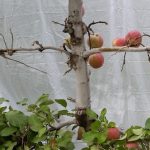
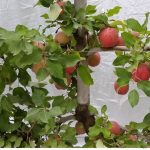
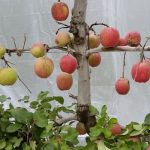
It is easier to see what is easily accessible when you take off the leaves. From the tree section above (a) when leaves were removed (b) the four apples behind the branch (c) are not accessible to the abundant robotics harvester. Photo credit Dan Steere.
What other challenges are the robots likely to have?
Quality risks: With the Abundant robot, fruit can be damaged if older stiff wood is sucked into the end effector with an apple. Programmers are teaching the machine to avoid this fruit which would not be marketable after being damaged. Grower cooperators are pruning to avoid having stiff limbs that protrude into the row.
Clusters: The Abundant robot is able to pick singles and doubles.
Stem Clipping: The Abundant robot cannot stem clip.
Strategies for making canopies robot ready
Going into this project roboticists and orchardists assumed that formally trained 2D canopies would be the most accessible. Indeed, the Auvil / Battunga type canopy is a great fit for this machine but so is an intentionally pruned tall spindle type tree. After research conducted the last three years they have found there are multiple tree architectures that have acceptable levels of accessibility, including both angled and vertical systems.
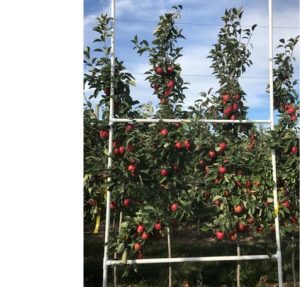
In order to analyze what systems would be effective Dan Steere, Dave Allan and WSU Extension’s Karen Lewis measured fruit accessibility in 12 blocks from 10 organizations. In each test row a 1.5m by 3m grid of fruiting area was evaluated for accessibility and quality risk at harvest.
It turns out that, as they assumed, the most accessible block was a formally trained 2 D canopy. It had 86% accessible fruit in the first year. However, another formal angle canopy only had 41% accessible fruit pointing out that how these canopies are managed and where the fruit resides within the trellised structure can make large differences. Vertical canopies could also be very successful. For example, with small changes in pruning Jeff Cleveringa, Starr Ranch had 77% accessible fruit, with more area for improvement as they learn how to work with the robotic system. “With small changes to thinning and pruning there are approaches for spindle trees which can make it amenable to mechanical harvest,” Steere explained.
Starr Ranch, Washington, United States. Jeff Cleveringa worked in a third leaf, Juici (Braeburn/Honeycrisp cross) block on a vertical wall spindle at 2 by 10 spacing for this trial. In order to work towards ‘robot ready’ he came back after winter pruning and took out the pendant/ long wood. This process took about two hours per acre. “In the future we should be able to do this all in the winter, now that we know what we are looking for,” Cleveringa explained. Before pruning the block had texture, ie… branches reaching further into the aisle, periodically down the row. In the robot ready, “it is a much flatter wall.”
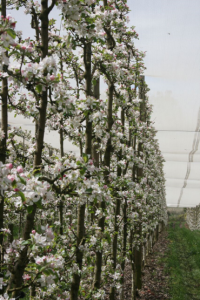
Battunga Orchards, Australia. Mark Trzaskuma worked with a tall spindle planting. The process of converting orchards has been underway for 4 years. The main thing they changed for the robotic harvester is space between rows and space between wires. New plantings are 3.1 m (10.2 ft) wire to wire to accommodate the width of the machine.
Ag First New Zealand. Craig Hornblow emphasized that it is not just about the robot. “If we focus on people, the canopies will become robot ready,” was Hornblow’s message. Our employees are working very hard and often at a meter and a half off the ground. With 3000 meters of climbing per hectare (from the base camp to summit of Everest is 3,500 meters), strategies which reduce this labor such as moving from 3D to 2D canopies can have advantages for not just the fruit but the people. For example, Hornblow did a small study looking at the harvest efficiency gains of individual pickers on the same orchard but in 2D vs 3D blocks. Picker 1 gained 30% efficiency when he moved to a 2D block. Picker 2 did not gain efficiency. Pickers 5 to 9 all gained 35% efficiency. “You may think, well picker 2 was just the lazy guy not picking very hard,” Hornblow teased the crowd, “But it turns out he was a very experienced picker who was so experienced he could pick quickly in any type of canopy. Think about how many of those type of pickers you still have – not many.” By moving to a 2D canopy the less experienced pickers are able to easily see fruit and don’t have to make as many decisions to harvest that fruit. This can save you money in the short term as well as move in the direction the robotic harvester might want.
In Summary
“There are several successful approaches,” said Steere. Think about small changes you can make to make fruit accessible when you prune and thin. While traditional large canopy trees are not likely to be conducive to robotic harvest, multiple types of 3D and 2D systems can be pruned to work.
Additional Resources
International Fruit Tree Association https://www.ifruittree.org/
Contacts
WSU Extension Specialist, Tree Fruit
509-754-2011 X 4307
WSU Extension Specialist, Tree Fruit
tianna.dupont@wsu.edu
(509) 663-8181 ext 211
Fruit Matters articles may only be republished with prior author permission © Washington State University. Reprint articles with permission must include: Originally published by Washington State Tree Fruit Extension Fruit Matters at treefruit.wsu.edu and a link to the original article.

